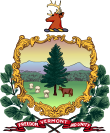Governor of Vermont facts for kids
Quick facts for kids Governor of Vermont |
|
|---|---|

Arms of the State of Vermont
|
|
| Government of Vermont | |
| Residence | None official |
| Seat | State House (Ceremonial office) The Pavilion (Working office) |
| Nominator | Political parties |
| Appointer | Majority vote |
| Term length | Two years, no term limits |
| Constituting instrument | Constitution of Vermont |
| Precursor | Governor of the Vermont Republic |
| Inaugural holder | Thomas Chittenden |
| Succession | Line of succession |
| Deputy | Lieutenant Governor of Vermont |
| Salary | $142,542 (2013) |
The governor of Vermont is the main leader of the U.S. state of Vermont. This person is chosen by voters every two years. Vermont and its neighbor New Hampshire are the only states that elect their governors this often. Most other states hold elections every four years.
There is no limit to how many times a person can be governor of Vermont. If no candidate gets more than half of all the votes, the state legislature then chooses the governor. The current governor of Vermont is Phil Scott, who is a Republican. He started his term on January 5, 2017, and is Vermont's 82nd governor.
What the Governor Does

The governor's main offices are in The Pavilion in Montpelier, which is the state capital. The governor also has a special office in the Vermont State House. This office is used for important events and during the time when the state lawmakers meet.
The Constitution of Vermont explains all the important jobs and powers of the governor. Here are some of them:
- Choosing Officials: The governor can pick people for many government jobs.
- Filling Empty Jobs: If a job in the government becomes empty, the governor can appoint someone to fill it until a new person is officially chosen.
- Talking with Other States: The governor communicates with leaders from other U.S. states.
- Working with Government: The governor works with other government officials, both civilian and military.
- Preparing for Lawmakers: The governor gets important topics ready to discuss with the state lawmakers.
- Granting Pardons: The governor can forgive crimes or reduce fines for people. However, they cannot do this for cases of treason (betraying the state) or impeachment (when an official is accused of wrongdoing).
- Making Sure Laws are Followed: The governor's job is to make sure that all state laws are carried out properly.
- Using State Money: The governor can use money from the state's Treasury, but only if the state lawmakers have approved it.
- Stopping Trade: For up to 30 days, the governor can stop certain goods from being bought or sold outside the state. This can happen when lawmakers are not meeting.
- Giving Licenses: The governor can give out official permissions or licenses as allowed by law.
- Calling Special Meetings: If needed, the governor can call extra meetings of the state lawmakers.
- Leading the Military: The governor is the top leader of Vermont's military forces, like the Vermont State Guard and Vermont National Guard. However, the governor cannot lead them in person during war or rebellion without the approval of the state Senate.
Vermont also has a lieutenant governor. This person is elected separately from the governor. If the governor leaves office because of death, resignation, or impeachment, the lieutenant governor takes over. The lieutenant governor also helps lead the state's military forces.
Who Becomes Governor Next
If the governor cannot do their job, there is a clear plan for who takes over. This plan is called the line of succession. Usually, the Lieutenant Governor of Vermont is next in line.
Images for kids
See also




